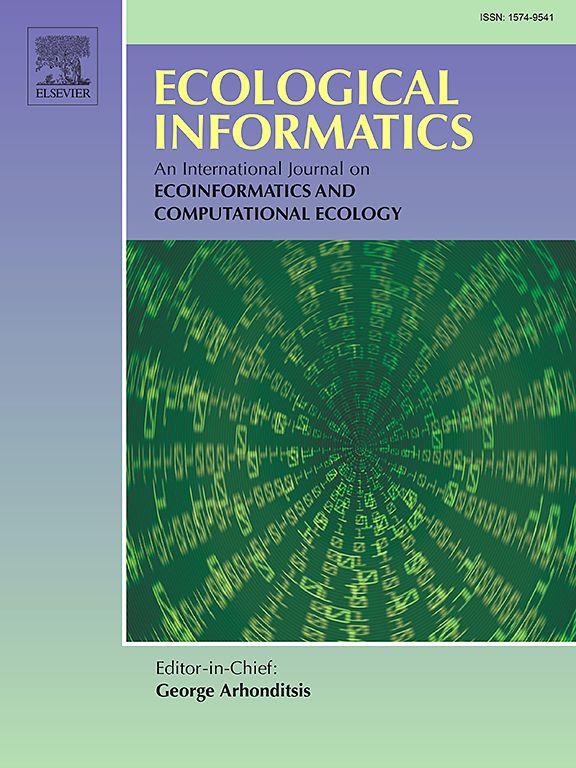利用LANDSAT时间序列和机器学习监测布列塔尼(法国)沿海湿地生态系统的动态
IF 5.8
2区 环境科学与生态学
Q1 ECOLOGY
引用次数: 0
摘要
沿海湿地可以防止侵蚀,减少洪水风险,并在干旱期间维持水道,从而可以缓解全球变暖及其对人类的影响。本研究旨在分析1990 - 2020年法国布列塔尼特定地区沿海湿地生态系统与城市化和海岸侵蚀主要驱动因素的时空动态关系。该研究利用了卫星图像时间序列(sit)、机器学习(ML)和随机森林(RF)算法的潜力。这些算法使软件能够从多个数据集自主学习,包括Landsat 4/5和8 sit存档图像。使用Corine Biotopes分类系统和多标量分析对数据集中的不同元素或生态系统进行分类。该研究提出了两种分析尺度:在整个布列塔尼沿海湿地的尺度上,以及在两个拉姆萨尔沿海湿地(圣米歇尔山湾和Audierne湾)的局部尺度上。结果显示了截然不同的空间格局。Audierne湾经历了显著的城市扩张,上游面积增加了24%,当地海岸侵蚀量达到1.63米/年,在1990-2020年期间,受影响最严重的地区退缩了约50米。在过去的30年里,该地区的湿地与海岸线平行消退,面积略有减少,减少了8%。相比之下,圣米歇尔山海湾的盐沼却在扩张。利用Landsat档案和自动海岸线探测方法,我们发现盐沼的面积在过去30年中增加了36%。在这两种嵌套的空间尺度方法中,所提出的空间方法在指定的时间尺度上生成关键生态系统动态的空间统计。结果为利益相关者提供了有用的信息。这些结果突出了布列塔尼海岸动态的多样性。本文章由计算机程序翻译,如有差异,请以英文原文为准。

Monitoring the dynamics of coastal wetlands ecosystems in Brittany (France) using LANDSAT time series and machine learning
Coastal wetlands protect against erosion, reduce flood risks, and maintain watercourses during periods of drought, which can mitigate global warming and its effects on humans. This study aims to analyse the spatio-temporal dynamics of coastal wetland ecosystems in relation to the main drivers of change urbanisation and coastal erosion in a specific region of Brittany (France) between 1990 and 2020. The study exploits the potential of satellite image time series (SITS), machine learning (ML), and Random Forest (RF) algorithms.
These algorithms enable the software to learn autonomously from multiple datasets, including Landsat 4/5 and 8 SITS archive images. The different elements or ecosystems within a dataset are classified into categories using the Corine Biotopes classification system and multi-scalar analyses. The study proposes two scales of analysis: at the scale of coastal wetlands throughout Brittany and at the local scale of two RAMSAR coastal wetlands (Mont-Saint-Michel Bay and Audierne Bay). The results revealed contrasting spatial patterns. The Audierne Bay has experienced significant urban expansion, with a 24% increase upstream, as well as coastal erosion reaching 1.63 m/year locally, with a retreat of approximately 50 m in the most affected areas during the period 1990–2020. The wetlands in this region are receding in parallel with the coastline and have slightly decreased in area over the last 30 years, with a reduction of 8%. In contrast, the Bay of Mont-Saint-Michel has seen an expansion of salt marshes. Using Landsat archives and an automated coastline detection method, we found that the area of salt marshes has increased by 36% over the last 30 years. In both nested spatial scale approaches, the proposed spatial methodology generates spatial statistics on the dynamics of key ecosystems at the designated time scale. The results provide useful information for stakeholders. These results highlight the diversity of coastal dynamics in Brittany.
求助全文
通过发布文献求助,成功后即可免费获取论文全文。
去求助
来源期刊

Ecological Informatics
环境科学-生态学
CiteScore
8.30
自引率
11.80%
发文量
346
审稿时长
46 days
期刊介绍:
The journal Ecological Informatics is devoted to the publication of high quality, peer-reviewed articles on all aspects of computational ecology, data science and biogeography. The scope of the journal takes into account the data-intensive nature of ecology, the growing capacity of information technology to access, harness and leverage complex data as well as the critical need for informing sustainable management in view of global environmental and climate change.
The nature of the journal is interdisciplinary at the crossover between ecology and informatics. It focuses on novel concepts and techniques for image- and genome-based monitoring and interpretation, sensor- and multimedia-based data acquisition, internet-based data archiving and sharing, data assimilation, modelling and prediction of ecological data.
 求助内容:
求助内容: 应助结果提醒方式:
应助结果提醒方式:


